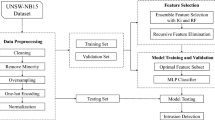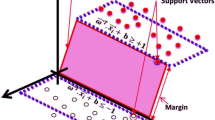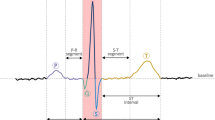Abstract
Feature selection by removing redundant and noisy features is one of the crucial steps in the classification problem. This paper presents a novel chaotic-based divide-and-conquer (CDC) algorithm to select optimal features from an available feature set (the UCI Arrhythmia Dataset). We then employed it for a quick and automatic heart function examination which is essential for monitoring the heart functionality of risky patients. The method begins with chaos numbers to select several features as cluster-heads. We used chaos sequences to escape from the dependency on initial values and getting stuck in local optima. Then, it assigns each feature to a group of cluster-heads and finally selects a representative from each group. The proposed method resulted in performance rates of 88.21%, 89.41%, 87.64%, and 86.54% in terms of accuracy, sensitivity, specificity, and F-measure, respectively. Since this method removes the redundant or improper features of the dataset without any data loss, it approximately needs 0.6 seconds to diagnose and classify cardiac arrhythmias. It is highly time-effective compared to the current state-of-the-art approaches.







Similar content being viewed by others
References
Ayar M, Sabamoniri S (2018) An ECG-based feature selection and heartbeat classification model using a hybrid heuristic algorithm. Inf Med Unlocked 13:167–175
Chen S, Hua W, Li Z, Li J, Gao X (2017) Heartbeat classification using projected and dynamic features of ECG signal. Biomed Signal Process Control 31:165–173
Rajesh KNVPS, Dhuli R (2017) Classification of ECG heartbeats using nonlinear decomposition methods and support vector machine. Comput Biol Med 87:271–284
Balouchestani M, Krishnan S (2016) Advanced K-means clustering algorithm for large ECG data sets based on a collaboration of compressed sensing theory and K-SVD approach. Signal, Image Video Process 10:113–120
Dilmac S, Korurek M (2015) ECG heart beat classification method based on modified ABC algorithm. Appl Soft Comput 36:641–655
Jadhav SM, Nalbalwar SL, Ghatol AA (2012) Artificial neural network models based cardiac arrhythmia disease diagnosis from ECG signal data. Int J Comput Appl 44:8–13
Yadav SS, Jadhav SM (2021) Detection of common risk factors for diagnosis of cardiac arrhythmia using machine learning algorithm. Expert Syst Appl 163:113807
Akdeniz K, Fulya K, Temel CK (2020) Time-frequency approach to ECG classification of myocardial infarction. Comput Electr Eng 84:106621
Song X, Gongping Y, Kuikui W, Yuwen H, Feng Y, Yilong Y (2020) Short term ECG classification with residual-concatenate network and metric learning. Multimed Tools Appl 79:22325–22336
Zhaia X, Zhoua Z, Chung T (2020) Semi-supervised learning for ECG classification without patient-specific labeled data. Expert Syst Appl 158:113411
Shaker AM, Tantawi MS, Tolba HA, Mohamed F (2020) Generalization of convolutional neural networks for ECG classification using generative adversarial networks. IEEE Access 8:35592–35605
Goel ST, Pradeep KG (2016) A fuzzy based approach for denoising of ECG signal using wavelet transform. Int J Bio-Sci Bio-Technol 8:143–156
Pal D, Mandana KM, Pal S, Sarkar D, Chakraborty C (2012) Fuzzy expert system approach for coronary artery disease screening using clinical parameters. Knowledge-Based Syst 36:162–174
Atal DK, Singh M (2020) Arrhythmia classification with ECG signals based on the optimization-enabled deep convolutional neural network. Comput Methods Prog Biomed 196:105607
Wu QS, Yangfan Y, Hui WX (2020) ECG signal classification with binarized convolutional neural network. Comput Biol Med 121:103800
Guler IU, Elif D (2007) Multiclass support vector machines for EEG-signals classification. IEEE Trans Inf Technol Biomed 11:117–126
Tripathy BK, Acharjya DP, Cynthya V (2013) A framework for intelligent medical diagnosis using rough set with formal concept analysis. Int J Artif Intell Appl 2:45–66
Dalal S, Birok R (2016) Analysis of ECG signals using hybrid classifier. Int Adv Res J Sci, Eng Technol 3:89–95
Raj S, Ray KC, Shankar O (2016) Cardiac arrhythmia beat classification using DOST and PSO tuned SVM. Comput Methods Prog Biomed 136:163–177
Ji S Li R, Shen S, Li B, Zhou B, Wang Z (2021) Heartbeat classification based on multifeature combination and stacking-DWKNN algorithm. J Healthc Eng 2021
Li Q, Wang X, Wang X, Ma B, Wang C, Shi Y (2021) An encrypted coverless information hiding method based on generative models. Inf Sci 553:19–30
Wang C, Wang X, Xia Z, Ma B, Shi Y-Q (2020) Image description with polar harmonic Fourier moments. IEEE Trans Circuits Syst Video Technol 30:4440–4452
Boeing G (2015) Chaos theory and the logistic map, at UC Berkeley
Dua D, Graff C (2019) UCI Machine Learning Repository. University of California, School of Information and Computer Science, Irvine, CA. http://archive.ics.uci.edu/ml
Kadam VJ, Yadav SS, Jadhav SM (2018) Soft-margin SVM incorporating feature selection using improved elitist GA for arrhythmia classification. In: International Conference on Intelligent Systems Design and Applications. pp. 965–976
Jadhav S, Nalbalwar S, Ghatol A (2014) Feature elimination based random subspace ensembles learning for ECG arrhythmia diagnosis. Soft Comput 18:579–587
Xu SS, Mak M-W, Cheung CC (2017) Deep neural networks versus support vector machines for ECG arrhythmia classification. In: 2017 IEEE International Conference on Multimedia & Expo Workshops (ICMEW), pp 127–132
Han Chang-Wook (2017) Detecting an ECG arrhythmia using cascade architectures of fuzzy neural networks. Adv Sci Technol Lett 143:272–275
Yılmaz E (2013) An expert system based on Fisher score and LS-SVM for cardiac arrhythmia diagnosis. Comput Math Methods Med 2013:6
Author information
Authors and Affiliations
Corresponding author
Additional information
Publisher's Note
Springer Nature remains neutral with regard to jurisdictional claims in published maps and institutional affiliations.
Rights and permissions
About this article
Cite this article
Ayar, M., Isazadeh, A., Gharehchopogh, F.S. et al. Chaotic-based divide-and-conquer feature selection method and its application in cardiac arrhythmia classification. J Supercomput 78, 5856–5882 (2022). https://doi.org/10.1007/s11227-021-04108-5
Accepted:
Published:
Issue Date:
DOI: https://doi.org/10.1007/s11227-021-04108-5




